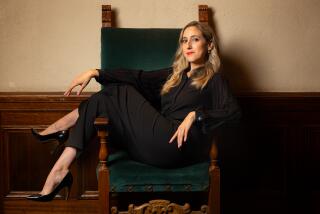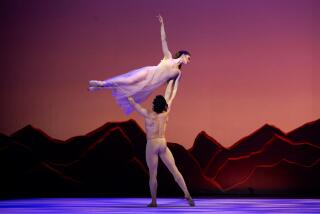Scaled-down ‘Beauty’
“Less is more” was never the guiding principle of 19th century Russian ballet, and you can argue that a minimalist or chamber-size “Sleeping Beauty” is no “Sleeping Beauty” at all.
That’s what the Royal Winnipeg Ballet performed at Cal State L.A. on Sunday: an abridged, reduced version of Marius Petipa’s 1890 masterpiece, one still credited to Petipa but with lots of choreography and even a whole scene by other hands.
Back home in Canada, a company spokesman confirmed, Galina Yordanova’s year-old staging features courtiers, corps members and children missing Sunday at the Luckman Theater -- along with a larger orchestra. And, yes, the court did look strangely underpopulated (especially in the prologue) and the choreographic design often cruelly oversimplified.
However, ballet audiences frequently see highlights programs in which small-scale excerpts from “Sleeping Beauty” are danced with enough style and spirit to conjure up the aura of the majestic original. It was ultimately the lack of that style and spirit that made the 145-minute Winnipeg “Beauty” seem so paltry.
Let’s start with the 24-piece tour orchestra led by Earl Stafford, and playing a generally judicious downsizing of Tchaikovsky’s score so slowly and lifelessly (especially in the first half of the evening) that its musicianship virtually guaranteed a somnolent “Beauty.”
But consistently prim, faceless dancing from the 32-member cast didn’t help. As the Lilac Fairy, Tara Birtwhistle exuded charm, intelligence and stylistic surety in a role overloaded with faux-Petipa. Vanessa Lawson as Aurora danced more of the real thing with great technical efficiency but no sense of involvement.
Not tall enough for Lawson, Jesus Corrales partnered her dutifully and delivered forceful, uneven solo dancing as Prince Desire. Dmitri Dovgoselets proved more reliable, if earthbound, as the Blue Bird, but Cindy Winsor outclassed him with effortless execution as Princess Florine.
Aris Karemanis displayed a fine jump as the Wolf; Carrie Broda had the knack of being simultaneously funny and classical as the White Cat. Emily Grizzell, Sarah Murphy-Dyson and Janet Sartore danced throughout the evening in various assignments, but never more vibrantly than in the last-act “Jewels” quartet with Daiva Preston.
Johnny Wright looked like the goddess of night as Carabosse, and initially attacked the role with menacing glee, but was required to seem terrified of all the fairy godmothers -- an innovation that robbed the plot of any semblance of dramatic tension.
Alternately formal and autumnal, the sets by Michael Eagan established an inviting environment for the ballet -- except, perhaps, for their curiously blank backdrops. Costumes by Shannon Lovelace and Anne Armit made the mazurka dancers appear more aristocratic than the principals but delivered period elegance without becoming overfussy.
Yordanova’s staging replaced some (but not all) of the 1890 mime with vague gesticulation and added solos for Prince Desire, as well as a scene in which he attacked Carabosse’s retinue with a sword before kissing Aurora awake.
These and other non-Petipa passages may well be relics of the inaccurate performing editions prevalent in Russia before the Kirov Ballet’s 1999 reconstruction of the complete original, but they are no longer defensible, historically or artistically.
More to Read
The biggest entertainment stories
Get our big stories about Hollywood, film, television, music, arts, culture and more right in your inbox as soon as they publish.
You may occasionally receive promotional content from the Los Angeles Times.










